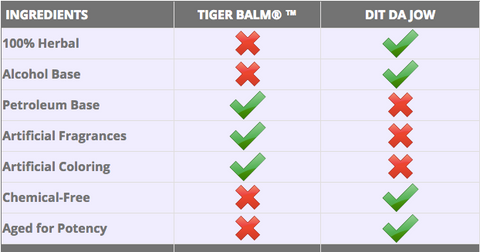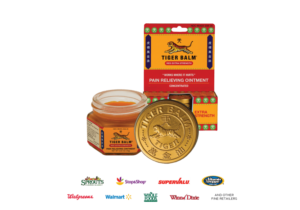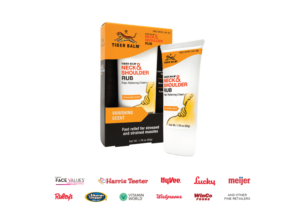Tiger Balm®™ vs. Dit Da Jow – Ingredients
Tiger Balm has become a household name for injury and pain, while dit da jow is a lesser-known product in this arena. Both appear to be based on the principles of Traditional Chinese medicine, and both are considered to provide analgesic pain relief. So what, if any, is the difference between Tiger Balm ingredients and dit da jow?



About Tiger Balm Ingredients®™
For decades, Tiger Balm has been a major “go-to” item for muscle pain and soreness. Even outside of Chinese medicine and martial arts circles, Tiger Balm was one of the early remedies available in public stores to deal with aches and pains in the muscles and joints, and the brand became well known. The Tiger Balm brand expanded over the years, creating new mixtures for their customers, in the hope of capturing more of the market and offering fresh products.
While today Tiger Balm is probably not as popular among athletes and martial artists as it once was, it is still a household name, and many people have an interest in how Tiger Balm ingredients differ from the more comprehensive dit da jow formulas arriving on the market. In this article, we will provide an analysis of Tiger Balm and discuss how it differs from the most popular dit da jow formulas.
Tiger Balm has several products with slightly different ingredients and uses, all of which are oil-based products (except for their liniment, which uses nearly the same formula). These products use a set of neutral carrier oils (oils to which the active ingredients are added for application to the skin), which provide no therapeutic benefit by themselves. Essential oils are added to the carrier oils to provide therapeutic benefit, and then inert wax is added to make the oil into a hard balm. The balm can then be rubbed into the skin. In some cases, Tiger Balm adds fragrances, artificial coloring and other chemical ingredients like propylene glycol and triethanolamine, which do not have any therapeutic effect and could potentially cause negative health reactions such as allergic reactions, skin irritation, itching, burning, scaling of the skin and other problems.[1] [2]
Because the various Tiger Balm formulas are so similar in their composition, we will discuss the primary product, and then follow up with some commentary about a subset of the Tiger balm lineup:
Tiger Balm “Extra”

Tiger Balm Extra is the main product in the line. Its active ingredients are camphor (referred to as Zhang Nao in TCM) and menthol (produced from the volatile oils of Bo He). These ingredients are added to some carrier oils, clove oil, and dementholised mint oil, and paraffin petrolatum, which is a petroleum jelly.
The percentage of Camphor in the formulas is 11%, while menthol is 10%. Given that most of the volume of the balm is made up of carrier oils and paraffin, these 2 ingredients comprise nearly all of the therapeutic function of the formula. According to TCM principles, Camphor is a very hot substance that has a strong ability to expel Wind-Damp. On the contrary, menthol provides a cooling energy used for Wind-Heat conditions. Menthol, by itself and when used externally, is primarily used for reduction of swelling and inflammation and can be useful at the site of joints. Combined, these 2 substances may help push out Dampness in the joints. They both provide significant physical sensation, and the heat that is representative of Tiger balm comes from the heat of the Camphor, and some from the menthol.
The Clove oil (oil extract from Ding Xiang) will provide some extra heat and provide some purely analgesic properties. And lastly, dementholised mint oil is simply oil of low concentration of menthol and is likely used as a filler.
Products containing high percentages of Camphor need to be used with caution and care. Patients can become very sick if they swallow chest rub made with camphor. Convulsions can begin within five minutes of ingestion. Excessive amounts of camphor rubbed on the chest can cause seizures as well. As little as 10ml of camphor can be lethal for children when swallowed. In addition to seizures, symptoms of camphor poisoning include nausea, vomiting, agitation and stomachaches.
Furthermore, doctors at the American Academy of Family Physicians report that camphor has no redeeming medical value. The poisons in the oil of camphor can transmit through the skin, making it a dangerous solution for pregnant women. Camphor can transfer through the placenta to the fetus, causing birth defects and stillborn births. Camphorated oil can be particularly dangerous and can cause birth defects even when inhaled.[3]
One final note on camphor: it is exceptionally dangerous for people suffering from Parkinson’s disease. It interferes with the medicine used in Parkinson and increases the toxicity level. It can turn out to be very poisonous in such cases.[4]
Petroleum jelly and oils are designed so that they remain on the surface of the skin and cannot penetrate very deeply (if at all) into the subcutaneous tissue. So, unless your injury is limited to the surface area of the skin, an oil-based formula cannot make contact with the injured cells. Even if it could penetrate deeply to the site of the injury, the formula, which consists almost entirely of camphor and menthol, does not have much in the way of healing power to offer toward the repair of the injured cells. This formula, like Ben Gay, Icy Hot, Bio-Freeze, and Battle Balm, is designed mostly to provide a skin sensation to mask or distract from the underlying pain.
Furthermore, petroleum-based ingredients like the paraffin petroleum in this Tiger Balm product can have negative side effects including finding the petroleum byproduct in breast tumours, the suffocation of the skin, premature ageing and aggravated acne.[5]
Tiger Balm Ultra is identical to Tiger Balm extra, save for 2 small details. It increases menthol content from 10% to 11%, and increases quantities of Clove oil and dementholised mint oil.
Tiger Balm “Neck & Shoulder”

The neck and shoulder rub utilizes the same concentrations of camphor and menthol as extra, but now adds eucalyptus oil to provide a more cooling sensation, some fragrances, and 1 peculiar addition: propylene glycol. This chemical compound is used in some food processing areas is also used as a coolant in heat exchange systems. It’s possible it is used here for removing heat from the site of application and has been associated with some negative side effects as noted above.
As can be seen from a review of these items, the differences between Tiger Balm formulas are very minor, primarily simple changes of concentrations of ingredients. In some cases, a new chemical ingredient is added. None of the Tiger Balm formulas has any focused use but is for generalized and superficial use to provide a physical sensation to the user that is intended to mask the pain rather than to promote maximum healing. Lastly, the use of fragrances, chemical dyes, propylene glycol, petroleum, and triethanolamine are particularly curious and potentially hazardous to the user.
About Dit Da Jow’s Ingredients
Dit Da Jow is a 100% herbal formula in an alcohol-based product. It does not use carrier oils or essential oils, fragrances, or fillers in its ingredients list. Rather, it uses a set of whole herbs straight from the earth, infused into a strong alcohol solution over a long period of time (6 months minimum). This alcohol based liquid is then applied to the site of injury. Each herb that is included in a dit da jow has some very specific therapeutic function—nothing is added without reason–and nothing is added merely for aesthetic purposes (such as chemical dyes, etc.). Even the alcohol provides benefit.
The alcohol solution penetrates deeply into the subcutaneous tissue carrying with it the bioactive herbal ingredients to nourish the injured cells underneath the skin. It also offers some minor blood invigorating properties when applied externally, and these are only two of a number of advantages dit da jow has over water or oil based products for healing of injuries.
Dit Da Jow can be rubbed into the skin, but it can also be made into a plaster or poultice by saturating a paper towel or gauze pad with liniment and taping to the skin—this is an incredibly effective way to get maximum benefit from a small amount. It can also be used as a soak, which can be especially helpful for hand and foot injuries.
Dit Da Jow formulas use a much larger set of ingredients than formulas like Tiger Balm and the other various mentholated analgesic formulas. This is because, the dit da jow formulas are designed to achieve healing of the cause of the injury or pain and not just to mask the symptoms.
Dit Da Jow formulas are designed to:
- Reduce inflammation and pain
- Increase blood circulation (to drive out stasis and reduce swelling)
- Promote healing and strengthening of bone, sinew, and muscle,
- Promote the health and proper movement of joints, and to
- Deal with arthritic types of complaints, range of motion issues, and pain.
The primary philosophy for the formulation of dit da jow is one that permeates all of Chinese medicine—that of synergism. The special blend of herbs is carefully designed to work in tandem with the body to help the body do what it does best – heal itself when given the right blend of nutritional building blocks to do so. We have learned, for example, that, according to TCM principles, Blood invigorators work better with penetrating Wind-Damp herbs; Wind-Damp herbs work better with anti-inflammatory herbs, and almost all formulas will elicit better patient response when combined with analgesic (pain-killing) herbs as well as herbs that reduce pain due to their ability to restore normal blood flow to an injured area of the body.
Let’s look at some examples of how best-selling dit da jow formulas by Plum Dragon Herbs are designed to work synergistically with the body to heal certain types of injuries.
Ho Family Formula
The Ho Family Dit Da Jow formula includes a variety of very strong Blood invigorators to strongly remove stasis. It also produces a great deal of heat through internal warming and Yang tonic herbs. These substances work in connection with the Blood invigorators to heal injury very quickly. However, because Ho Family also has a battery of herbs to specifically reduce inflammation, it can be used on reddened, painful areas where there is heat. These herbs are combined with a set of analgesic herbs that work together to create a powerfully healing and pain-killing combination. The end result: a focused formula meant for strongly healing injury to muscles and joints.[5]
Bruise Juice Formula
Bruise Juice has a significantly different formula construction than the Ho Family Dit Da Jow previously discussed. The Bruise Juice still carefully combines a variety of herbs to perform all of its synergistic qualities, but it is designed with a different focus. It seeks, first and foremost, to reduce inflammation and strongly drive out Blood stasis. Rather than producing heat like the Ho Family formula, it is a cooling mix that promotes the reduction of inflammation. It is primarily a formula for reducing very serious bruising, swelling, and stagnation.
Ancestors Advanced Dit Da Jow
Shifting focus yet again, the Ancestors Advanced Dit Da Jow is designed specifically for the strengthening (or conditioning) and healing of bone and sinew. This formula contains strong blood moving herbs, and is directed toward promotion of joint health with Wind-Damp herbs and Kidney Yang tonic herbs. Compared to Ho Family Dit Da Jow, it doesn’t address pain with analgesic herbs, and compared to Bruise Juice, it doesn’t reduce inflammation from injury to the same degree. Its purpose is more to prevent injury than to heal it, or to feed mega-nutrition to joint cells damaged by arthritis.
All three of these formulas have the same philosophy of dit da jow in common: They use a synergistic blend of herbs to address certain specific functions of the body to aid and support the body in its own self-healing work.
Key Differences Between Tiger Balm and Dit Da Jow Ingredients
When we step back from Tiger Balm and Plum Dragon Dit Da Jow formulas and attempt to compare them, we find that they are actually very different products with very different goals. A couple of striking items are apparent:
- Masking vs Healing – Tiger Balm is an oil-based substance, with the addition of essential oils, waxes and chemicals. The therapeutic effect comes from the essential oils, is generalized and superficial and intended to mask pain. Plum Dragon Dit Da Jow is alcohol-based, whereby whole herbs (with all of their bioactive compounds in tact, not just their oils) are aged in alcohol to create a nutrition-dense, medicinal liniment that is injury specific and intended to help the body heal injury rapidly. Every ingredient in the dit da jow formula has a nourishing and therapeutic benefit that aids the body in healing itself. Where Plum Dragon Dit Da Jow is composed entirely of herbs that are meant to address the body’s healing process from injury or physical trauma, Tiger Balm ingredients focus more on the physical sensation that masks the pain by overwhelming the nerves at the skin level. Camphor, menthol, and eucalyptus can be very useful ingredients, but when used by themselves in a formula, they act mostly to create a warming, tingling feeling on the skin in order to mask pain. Plum Dragon Dit Da Jow does not generally offer any strong tingling sensation to the user as their goal is to help the body heal the injury or relieve the pain, not mask the pain.
- Synergistic Healing – Tiger Balm does not adopt the philosophy of synergistic healing that we see in other formulas in Chinese medicine. Tiger Balm is made of a few simple ingredients that are not geared towards maximum healing. Tiger Balm’s ingredients don’t generally work together and they don’t address specific aspects of injury for healing.
- Quality of Ingredients – Tiger Balm is highly processed. It includes more cheaply made oils such as dementholised mint oil, and fragrances that alter how the product smells without adding therapeutic benefit. It also contains potentially harmful ingredients such as chemical food coloring and propylene glycol. We consider it strange for these ingredients to be added to a product that is supposed to have a history rich in Chinese medicine. By contrast, Plum Dragon is committed to producing a pure product that is free of contaminants, chemicals, added fragrances and colorings. We are even concerned about contamination of plastic residues and our liquid dit da jow formulas are aged, stored and distributed in glass from start to finish to prevent any plastic chemicals from leeching into our formulas. Because they are pure and unprocessed, Plum Dragon formulas are differing shades of brown with flecks of herbs in them and they smell just like the herbs that are used to make them. While this may seem a bit odd to those accustomed to clear or white antiseptic formulas made from chemical ingredients, users come to appreciate this pure, unadulterated, natural and powerful medicine for what it is without the need to enhance it with further processing, artificial coloring or chemical ingredients that may be harmful to the user.
- Penetration Level – While balms can be convenient to rub into the skin and keep mess to a minimum, balms sit on the surface of the skin and cannot penetrate deeply to the injured cells below the surface. Plum Dragon Dit Da Jow can penetrate deeply into the subcutaneous tissue. It also has a diverse set of methods of use. Both the jow and the herbs that made the jow can be used as a plaster or poultice, and the jow can be also used as a soak or added to a bath.
Conclusion
It is difficult to further compare Tiger Balm ingredients to a well-made dit da jow formula beyond this context, because, in many ways, Tiger Balm is a different type of product. In fact, the closest type of product to compare to Tiger Balm is perhaps Vicks Vapo-Rub, which is composed of slightly lower quantities of the same active ingredients (camphor, menthol, and eucalyptus oil), but costs about half as much per ounce. Hopefully, this summary has given you a clear picture of just how different Plum Dragon Dit Da Jow is from Tiger Balm and other camphor/menthol-based analgesic rubs – and – why you need to keep jow in your gym bag, dojo, training school, and acupuncture or chiropractic clinic.
Products such as Tiger balm may be useful in a pinch or on the run to give some simple pain reduction or pain masking. But, if rapid recovery and deep healing of an injury is the desired outcome, or in the case of a trauma injury, they should be set aside as soon as possible in favor of a strong dit da jow formula that is meant to spur the healing process and address all the various issues that arise from injury and training.
[1] Propylene Glycol ,2. Health Effects. CDC Tox Facts Sheet. https://www.atsdr.cdc.gov/ToxProfiles/tp189-c2.pdf
[2] Toxipedia.org Propylene+Glycol
[3] Camphor Dangers. http://www.livestrong.com/article/111501-camphor-dangers/
[4] http://www.stylecraze.com/articles/unexpected-side-effects-of-camphor/
[5] Side Effects of Petrolatum. http://www.livestrong.com/article/226763-side-effects-of-petrolatum/
[6] Why Does Ho Family Dit Da Jow Work So Well. https://plumdragonherbs.com/why-does-ho-family-dit-da-jow-work-so-well/








